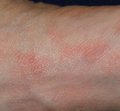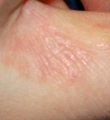In temperate countries there are epidemics of the mite infestation scabies (figs 1 and 2) every 20-30 years. The present epidemic of scabies in the United Kingdom originated in the catchment population of this hospital in early 1990 and continues to be a problem? Failure to treat contacts adequately and to apply treatment correctly are acknowledged problems. Cases in which genuine resistance of scabies mites seems probable have also been reported. The following cases illustrate a new pitfall that can lead to treatment failure.
[Figures 1-2 ILLUSTRATION OMITTED]
Case reports
Family 1
A 53 year old woman and her husband acquired scabies--probably from their 25 year old son. They were all treated with topical permethrin, which was purchased "over the counter" from the pharmacist on the advice of their general practitioners. Over a period of six months the family used at least five bottles of permethrin and applied it for up to 24 hours, but with no success. Affected members consulted different general practitioners in two separate practices, and part of the reason for treatment failure may have been the fact that they were not treated concurrently from the outset. Shortly before the woman was due to attend a dermatology clinic, the family treated themselves with a malathion preparation (Derbac-M, Seton Scholl), and their symptoms resolved rapidly. The woman kept her appointment because of the duration and intensity of her symptoms (the other family members were not examined as their symptoms had resolved). At the consultation it was learned that they had been using a 1% permethrin cream rinse for head lice (Lyclear, Warner Lambert), which is not formulated to eradicate scabies infestation. The patient had apparently queried the suitability of the product at the pharmacy when she bought it as the instructions inside the package showed that the lotion was to be applied to the scalp, but she had been assured that this was the correct treatment for scabies.
Family 2
A 10 year old girl was referred to the dermatology clinic because of a 12 month history of suspected scabies. She had been treated on at least two occasions each with malathion and permethrin (all prescribed by her general practitioners), and subsequently with topical steroids, but without success. It seemed that the permethrin preparation used was the 1% cream rinse--the girl had complained that the product caused stinging and her mother reported that she had used the "lotion for nits" which she had applied briefly (10 minutes) as a washing solution. No other family members had been affected, but the child had the typical rash and burrows of scabies on the hands. The infestation was subsequently treated successfully with 5% permethrin cream.
Family 3
A 46 year old woman was referred to the dermatology clinic because of she had a persistent itch after using permethrin (Lyclear) to treat scabies infestation. The other three members of her family were also affected. A few excoriations but no burrows were evident on her skin. However, a burrow was found and scabies mite extracted at a subsequent visit to the clinic. Review of the patient's management showed that she had received several treatments--on one occasion she was given 5% permethrin cream, but on the other occasions she was treated with the 1% cream rinse. On the only occasion when all four family members had been treated concurrently, the preparation used was 1% permethrin cream rinse, prescribed by the general practitioner, and applied overnight. The whole family was subsequently treated successfully with 5% permethrin cream.
Discussion
The prevalence of scabies in the United Kingdom cannot be documented accurately as many patients treat themselves using preparations they have bought over the counter. Cases are usually diagnosed on clinical suspicion alone, and patients may have several affected or potentially affected contacts (family, sexual partners, schoolmates, etc) who are usually not documented separately in prevalence figures. Counting the number of prescriptions for scabicides is an inaccurate way of measuring the scale of the problem, as some preparations can be purchased over the counter and can also be used for other infestations or incorrectly for other causes of itching. However, there are cyclical epidemics of scabies in most Western countries. The current epidemic in the United Kingdom was reported initially from our catchment population in 1991, and at one stage up to 8% of referrals at one dermatology clinic were related to scabies.[1]
Treatments for scabies are generally topical, although systemic ivermectin (not licensed in the United Kingdom) is also very effective, and other veterinary avermectins such as doramectin are also likely to work. Pyrethrins are a natural component of pyrethrum, an extract from chrysanthemum flowers, and have been used as insecticides for over a century.[2] Allethrin, the first synthetic pyrethroid, was developed 50 years ago, and permethrin was used for treating body lice over 20 years ago. Several studies have shown that 1% permethrin cream rinse is better than lindane ([Gamma] benzene hydrochloride) for treating head lice, and has a better safety profile because less is absorbed systemically. With the 5% permethrin preparation for treating scabies, a response rate of over 90% is anticipated after a single application, and success can often be improved by a second treatment.
As scabies epidemics progress, clinicians generally see some cases in which treatment fails because mites become resistant, rather than any of the other possible causes. For example, resistance to lindane (now withdrawn) was well known,[3 4] and we see patients in whom malathion applied by a nurse has failed to eradicate the mites. However, we have not previously seen treatment failure with permethrin, which is our first choice agent. These reports of failure with permethrin were therefore clinically striking, especially as scabies infestation in another family of three subjects (whom we were unable to contact for publication consent) had also cleared with 5% permethrin dermal cream after treatment with the 1% cream rinse had failed.
The most likely explanation for the treatment failure in these cases was the lower concentration of permethrin in the cream rinse. There is a precedent for "relative resistance" to permethrin. Infestation with head lice that seem to be resistant to 1% permethrin cream rinse has been successfully treated by applying the 5% permethrin cream overnight.[5 6] However, there are other explanations for treatment failure related to the product used. The dermal cream should be applied for 8-12 hours, while users are instructed to apply the cream rinse for 10 minutes only. Ten minutes is not long enough to enable the permethrin to penetrate burrows or skin, a factor that was relevant in one case reported here. The first family responded to malathion, and the mites with which they were infested may have been resistant to permethrin, although this has not been seen before locally. Finally, stinging caused by the isopropanol in the 1% permethrin cream rinse was a feature in the case of the 10 year old girl and could have led to suboptimal application of treatment, as occurred frequently with alcoholic solutions of lindane before these were withdrawn.
The fact that the two permethrin preparations have the same name probably caused confusion, leading to incorrect dispensing and inadequate treatment for scabies. Lyclear dermal cream is a 5% permethrin preparation for scabies, while Lyclear cream rinse is a 1% scalp preparation for head lice, but either could have been abbreviated to "Lyclear cream" or simply "Lyclear." The same preparations are available in parts of Europe under the proprietary name Nix, again as dermal cream or cream rinse, so this potential for error may not be confined to the United Kingdom. Indeed, the manufacturers are aware of some instances where this problem has occurred previously (Warner-Lambert, personal communication). In the United States, Warner-Lambert markets the 1% permethrin preparation as Nix and the 5% preparation as Elimite. My first patient had bought treatment from a chemist, and had queried the fact that the packaging contained no instructions for use in scabies. In her case, the error was probably initially in pharmaceutical dispensing. In the other families, the treatments were prescribed by the general practitioner and problem could have been incorrect prescribing or incorrect dispensing.
It is important that scabies, once diagnosed, is adequately treated in order to prevent its spread to other contacts. Permethrin is probably the safest preparation for scabies treatment, but the correct formulation must be used to achieve eradication. Prescriptions or advice to purchase permethrin should therefore specify the full prescription name, the concentration, or the treatment indication.
Contributors: NHC is the sole contributor.
[1] Cox NH, Paterson WD. Epidemiology of scabies: the new epidemic Lancet 1991;337:1547-8.
[2] Taplin D, Meinking TL. Pyrethrins and pyrethroids in dermatology. Arch Dermatol 1990;126:213-21.
[3] Taplin D, Meinking TL, Porcelain SL, Castillero PM, Chen JA. Permethrin 5% dermal cream: a new treatment for scabies. J Am Acad Dermatol 1986;15:995-1001.
[4] Brown S, Becher J, Brady W. Treatment of ectoparasitic infections: review of the English-language literature, 1982-1992. Clinical Infectious Diseases 1995;20(suppl 1):S104-9.
[5] Burgess IF, Peock S, Brown CM, Kaufman J. Head lice resistant to pyrethroid insecticides in Britain. BMJ 1995;311:752.
[6] Burkhart CG, Burkhart CN, Burkhart KM. An assessment of topical and oral prescription and over-the-counter treatments for head lice. J Am Acad Dermatol 1998;38:979-82.
(Accepted 5 July 1999)
The correct permethrin preparation for treating scabies is 5% dermal cream, not 1% cream rinse
Department of Dermatology, Cumberland Infirmary, Carlisle CA2 7HY
N H Cox consultant
BMJ 2000;320:37-8
COPYRIGHT 2000 British Medical Association
COPYRIGHT 2000 Gale Group




